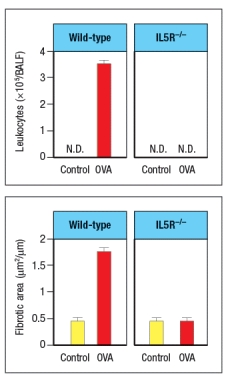Multiple Choice
Allergen-induced airway remodeling in mice is used as a model for human allergic asthma. This disease is induced by first sensitizing mice to the protein antigen, chicken ovalbumin (OVA) by intraperitoneal immunization with OVA in a TH2-inducing adjuvant. Three weeks later, mice are challenged by inhalation of aerosolized OVA (or saline alone, as a control) daily for the following three weeks. At the end of the entire six week period, the lungs of the mice are examined for leukocyte numbers in the bronchial alveolar lavage fluid (BALF) and for tissue remodeling as assessed by measuring fibrotic areas in the lung tissue. To determine the cell type most likely responsible for the tissue damage in this disease, IL-5 receptor-deficient mice (IL5R-/-) are compared to wild-type, as shown in Figure Q13) .  airway remodeling disease model is:
airway remodeling disease model is:
A) Neutrophils
B) Macrophages
C) Mast cells
D) TH2 cells
E) Eosinophils
Correct Answer:

Verified
Correct Answer:
Verified
Q3: A relatively new form of therapy for
Q4: Red blood cells are common targets
Q5: IL-33 is a cytokine known
Q6: In mice, an allergic response in the
Q7: Allergic responses to inhaled antigens occur when
Q9: In the late 1990s, compounds that functioned
Q10: The response of most individuals to
Q11: Common allergens that trigger atopic responses in
Q12: Individuals with peanut allergies can exhibit a
Q13: Genome-wide association studies of large cohorts of